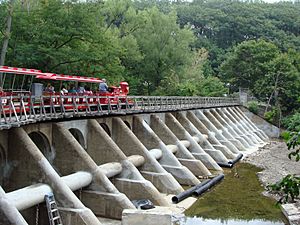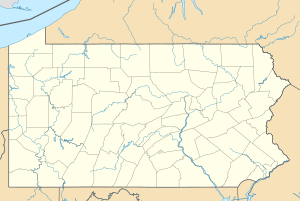Mill Creek (Lake Erie) facts for kids
Quick facts for kids Mill Creek |
|
|---|---|

Mill Creek south of the tube, looking downstream
|
|
|
Location of the mouth of Mill Creek in Pennsylvania
|
|
| Country | United States |
| State | Pennsylvania |
| County | Erie |
| Physical characteristics | |
| Main source | Millcreek Township, Pennsylvania 1,029 ft (314 m) 42°6′29″N 80°0′15″W / 42.10806°N 80.00417°W |
| River mouth | Presque Isle Bay Downtown Erie, Pennsylvania 577 ft (176 m) 42°8′37″N 80°4′49″W / 42.14361°N 80.08028°W |
| Length | 18.96 mi (30.51 km) |
| Basin features | |
| Basin size | 12.20 sq mi (31.6 km2) |
Mill Creek is a stream about 19 miles (30.6 km) long. It flows through Erie County in Pennsylvania, USA. This creek starts in Millcreek Township and then goes through the city of Erie. Finally, it empties into Presque Isle Bay, which is part of Lake Erie. A big part of the creek in the city flows through a special underground tunnel called the Mill Creek Tube. This tunnel was built after a very bad flood happened in 1915.
Contents
Where Mill Creek Flows
Mill Creek starts in the far eastern part of Millcreek Township. It flows west and joins up with a few smaller streams. The creek then generally follows Pennsylvania Route 505 (Glenwood Park Avenue) north. After this, the creek goes underground.

The creek flows right through the middle of the Erie Zoo. You can see several bridges crossing the creek there. One of these bridges is special. It's built to catch large pieces of wood and other debris. This "drift catcher" stops big items from floating into the underground tunnel further downstream. The zoo's train also uses this drift catcher bridge to cross over Mill Creek.
At 30th Street, Mill Creek goes underground. It travels for over 2 miles (3.2 km) through the Mill Creek Tube. This tube passes right underneath downtown Erie. The creek comes back above ground on the northern side of the Bayfront Parkway. From there, it flows into Presque Isle Bay at the eastern end, near South Pier.
The Story of Mill Creek
The city of Erie and Millcreek Township were both settled in 1795. Erie County was officially created in 1800.
Early Mills Along the Creek
The very first mill in Erie County was built at the mouth of Mill Creek. This is how the creek got its name. By 1835, there were many mills along the creek. These included four gristmills, which grind grain, and thirteen sawmills, which cut wood. All these mills used the power of Mill Creek to operate.
The Great Flood of 1915
Mill Creek had a history of overflowing its banks, like in 1893. But the worst flood happened on August 3, 1915. Heavy storms brought over 5.77 inches (14.7 cm) of rain in just 13 hours. The ground became very wet, and the creek banks started to collapse. Many small buildings near the creek were swept into the water.
This debris blocked a culvert (a tunnel for water) under 26th Street. This blockage caused a huge amount of water to build up, forming a temporary lake that stretched for four city blocks. People tried to clear the blockage with dynamite, but it didn't work.
Around 8:30 PM, the culvert broke open. The trapped floodwaters rushed into downtown Erie. The flood moved very fast, at about 25 miles per hour (40 km/h). It left a path of destruction 3 miles (4.8 km) long and 6 blocks wide. In total, 225 houses were damaged or completely destroyed. Over 300 other buildings were also hit. Sadly, 36 people lost their lives. To prevent such a disaster from happening again, the city decided to put Mill Creek into a concrete tube under the city.
The Mill Creek Tube
The Mill Creek Tube is a large, strong concrete tunnel. It is 22 feet (6.7 m) wide, 19 feet (5.8 m) tall, and 12,280 feet (3,743 m) long. This tube carries Mill Creek underground through the city of Erie. It was built to stop another terrible flood like the one in 1915. The tube was finished in 1923.
The tube starts south of West 30th Street and ends north of the Bayfront Parkway. It used a lot of cement, over 70,000 barrels (13,600 short tons). The water in the tube drops 200 feet (61 m) from start to finish.
The tube is big enough for a Jeep or a pickup truck to drive through and even turn around. Because of its size, sometimes people get swept into the tube when the creek is high. This can lead to water rescues if they get stuck. For example, on July 26, 2007, three teenagers were caught in the fast-moving Mill Creek. Firefighters rescued one near the tube's mouth and another near 26th Street. The third teenager traveled through the entire tube before being rescued.
About 1 mile (1.6 km) upstream from the tube, there is a drift catcher. This structure stops large debris from reaching the tube. The catcher is 209 feet (64 m) long and 18 feet (5.5 m) high. It was built at the same time as the tube. In 1965, the catcher was changed to let the Erie Zoo's miniature railroad cross over it. The drift catcher was repaired from May to August 2010. This $476,800 project fixed cracks, repaired old concrete, and checked a retaining wall of the bridge.



